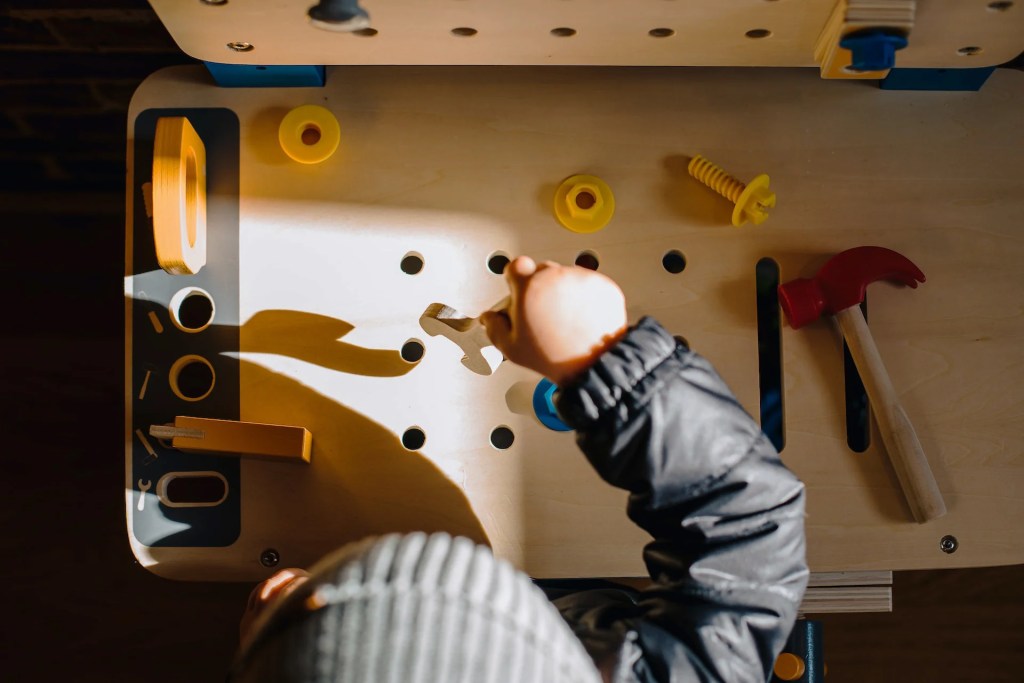Your cart is currently empty!
When will my baby start talking? It’s a question all new parents ask, and rightfully so. You spend every waking moment taking care of your infant without *much* reciprocity. From cooing to babbling, here’s what to expect during their first years.
Here’s What You Need To Know:
- Studies show that infants go through approximately four main stages of speech development.
- For the first six months, babies communicate primarily through crying, cooing, and laughing.
- Around 7 months, your little one can say ‘maaaaaa’, ‘baaaaaa’, and ‘daaaaaa’.
- At 7-10 months, your baby can say “ba ba” or “di di”.
- At 11 – 18 months, your little one will say their first words.
- Around 2.5 years, your toddler can start making sentences.
Talk the Talk & Walk the Walk
Studies show that infants go through approximately four main stages of speech development. During the first two months, parents experience the expressions of discomfort (crying). Around 2-4 months, infants begin to make comfort sounds, such as coos. Around 4-7 months, babies engage in non speech-like vocalizations and vocal play. This includes yelling, yawns, and blowing a raspberry.
Then, at 7 months, things start getting really exciting.




The Babbling Stage
Marginal Babbling: Around 7 months, your baby should begin annunciating different vowels and consonants. You will hear things like ‘maaaaaa’, ‘baaaaaa’, and ‘daaaaaa’, followed by a mumble-jumble of other sounds.
It will seem like your baby is telling you a very detailed story filled with emotional highs and lows. It’s not just in your head, scientists at the University of Washington have found that the parts of the brain associated with motor planning for speech (Broca’s area, cerebellum) light up when a parent is speaking to the baby — indicating that the baby is already trying to figure out the physical mechanics of responding.
Canonical Babbling: Babies all over the world produce the same kind of early canonical babbling sounds. It is a syllabic babble that combines a consonant and a vowel. This occurs during the developmental period between 7 and 10 months.
Babies begin to make syllables, such as “ba ba” or “di di” that include a consonant and a vowel. Your baby might also vocalize combinations of different syllables, such as “ma di da.” As babies get older and synaptic pruning takes place, they will babble only using the sounds they hear around them.
The Holophrastic Stage
This stage occurs between around 11 – 18 months. At this stage, most babies produce a few single words. Your baby will know which words grab your attention: namely, mama and dada. They WILL overuse it.
Scientists have also discovered that words with repeating sounds are easier for babies to say. There is an ability “hard-wired inside the human brain to recognize repeating sounds.” Your child may also tend to over-generalize a word. For example, all four-legged creatures might become “dog.”
The Two-Word Stage
Around two years, your baby will say two word sentences. These utterances are usually noun-noun or noun-verb. Examples include, “me go,” “doggie bark”, and “mama here.” At this stage, a child’s vocabulary usually develops to around 50 words. Then it will take a dramatic leap forward. This is commonly referred to as the “word spurt.”
The two-word stage only contains content words. That means no function words (determiners, conjunctions, prepositions, pronouns, auxiliary verbs, modals, or qualifiers). However, your baby is developing an understanding of how to categorize everything.
The Telegraphic Stage
This stage begins around 2.5 years. Your little one can expand their vocabulary by as many as 10 to 12 new words a day. This is also when the who, what, when, where, and why questions begin.
Your child will have a much better understanding of syntax and semantics. Their sentences will generally follow the order of subject, verb, and object.
Should I “baby talk” my little one?
Researchers have found a value in “baby talk,” or infant-directed speech. You may feel a bit batty speaking to your baby in slow and exaggerated speech, but it helps babies imitate what they hear and see.
Even birds and mammals use baby talk. Research shows that bat mamas use it when communicating with their little ones. It helps mediate social interactions and influences the vocal development of their offspring.
Not so batty after all.

Summary
A baby’s journey towards their first word begins sooner than you may have thought. Your baby was even learning in the womb by listening to you speak. Every baby is different, but these are the common stages to look for during speech development.
A good way to encourage lexicon growth is by talking to your little one on a daily basis. One easy way is to narrate your day to your mini (think of yourself as Morgan Freeman). Pretty soon, you won’t be able to get them to stop talking.











